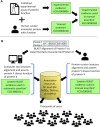ECO: the Evidence and Conclusion Ontology, an update for 2022
- PMID: 34986598
- PMCID: PMC8728134
- DOI: 10.1093/nar/gkab1025
ECO: the Evidence and Conclusion Ontology, an update for 2022
Abstract
The Evidence and Conclusion Ontology (ECO) is a community resource that provides an ontology of terms used to capture the type of evidence that supports biomedical annotations and assertions. Consistent capture of evidence information with ECO allows tracking of annotation provenance, establishment of quality control measures, and evidence-based data mining. ECO is in use by dozens of data repositories and resources with both specific and general areas of focus. ECO is continually being expanded and enhanced in response to user requests as well as our aim to adhere to community best-practices for ontology development. The ECO support team engages in multiple collaborations with other ontologies and annotating groups. Here we report on recent updates to the ECO ontology itself as well as associated resources that are available through this project. ECO project products are freely available for download from the project website (https://evidenceontology.org/) and GitHub (https://github.com/evidenceontology/evidenceontology). ECO is released into the public domain under a CC0 1.0 Universal license.
© The Author(s) 2021. Published by Oxford University Press on behalf of Nucleic Acids Research.
Figures




